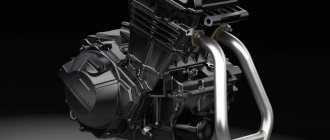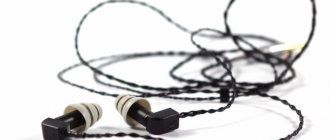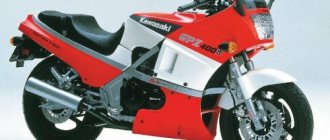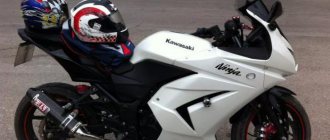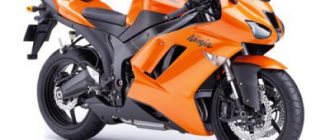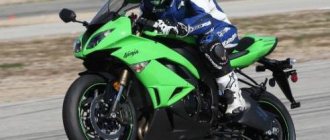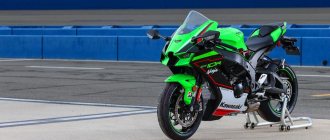Among the legendary Kawasaki models, the ZX-6R occupies one of the leading positions. In the course of evolution, engineers managed to create one of the best mid-sized sportbikes in history. Despite all the efforts of competitors, with each new generation “Ninja” becomes the most evil sports “six hundred”. Thousands of athletes around the world have appreciated the progressive engineering solutions, reliability and unpretentiousness. Different generations of this motorcycle are loved in their own way by both motorcycle racers and stunt riders.
First generation (1995–1997)
In 1995, the Kawasaki ZZ - R 600 (the model remained in production, but was reoriented as a sports tourer) was replaced by a completely new 600 cm3 sports bike, the Kawasaki ZX -6 R Ninja. The motorcycle at that time had a competitive 105 hp engine. s., progressive suspensions and good braking mechanisms, but its main advantage is the aluminum frame, the presence of which none of the competing motorcycles in the same class could boast of.
The engine design is proven and reliable, which cannot be said about the gearbox; quite often there are problems with the second gear slipping out (which, by and large, can be considered the result of a long mileage and careless use). Problems with fuel pump failure are common.
On motorcycles in 1995, the frame cracked even with the slightest drop (the manufacturer managed to replace most of the frames under warranty); in 1996, the structure was strengthened.
Externally, the “six hundred” looks almost the same as the older model ZX -9 R. The plastic tail is durable, but has a catch - due to the design features, installation of the sliders is complicated.
Finding a fully technically functional first-generation motorcycle on the secondary market (especially one that has traveled around Russia) is a great success. To a certain extent, it is pointless to talk about any special narrow malfunctions; the condition of each specific surviving specimen is made up of a bunch of breakdowns acquired over many thousands of kilometers. Consumables are freely available, but the same cannot be said about spare parts.
Engine
The motorcycle is equipped with a four-stroke engine. It has 4 cylinders. The type of engine is in-line. It is liquid cooled. The compression ratio of more modern versions is 12.9:1. As for the working volume, it is 636 cubic centimeters.
New versions of the motorcycle can reach a speed of 100 kilometers per hour in 3 seconds, and not in 3.5, as before. The maximum speed of this model is 267 kilometers per hour, and it has been like that from the very beginning, and this was 1995! Of course, it also has to do with the motorcycle engine.
The maximum torque is now 71 Newton meters at 11,500 rpm. It is worth noting that at first it was only 64 Newton meters at 10,000 rpm, but even now this does not look like a small figure!
Power at its peak is now 131 horsepower at 13,500 rpm. At first, the maximum power was 105 horsepower at 12,500 rpm, which is also a very good indicator.
Transmission
The gearbox of this motorcycle consists of six stages. The drive is of a chain type. This is quite enough for the bike to easily reveal the potential of its engine and be successfully controlled at different speeds. Perhaps the transmission will be changed someday, but even if not, it will not be critical.
Second generation (1998–1999)
Two years after the start of production, the motorcycle received a number of cosmetic changes. The exhaust pipe changed color from black to silver, and the driver's seat received an increase in length. The rear subframe is no longer integral with the frame, but is a removable part. The plastic cladding is all new with slightly smoother curves. The engine and gearbox remain the same, a slight increase in power is the result of painstaking adjustments to the intake and exhaust systems. It is impossible not to note the appearance of six-piston front calipers as standard (previously four-piston ones were installed).
According to modern ideas, the Kawasaki ZX -6 R of the first and second generations have long been out of the sports status, now completely different power and weight indicators are at stake. The prevalence of such motorcycles on the secondary market is small. The owner will inevitably have problems finding spare parts. The search for a living device is complicated by its venerable age.
About reliability
As befits a real ninja, reliability here is at a high level .
This is what contributed to the growing popularity of this bike among stunt riders.
A powerful subframe and increased engine resources allow it to withstand serious mechanical loads while performing various stunts.
Early models of these motorcycles had some engine problems . Considering that the engine had high speeds, it was quite powerful, but could not provide the required resource life.
Therefore, those choosing a Kawasaki ZX6R from the range of models from the 90s or early 2000s need to take these features very seriously.
Caring for this motorcycle does not require compliance with any special rules.
However, you will have to comply with the basic requirements, which determine timely refueling, checking tires, good engine care, timely oil changes, as well as proper preparation for the winter period.
Third generation (2000–2002)
By 2000, the Kawasaki ZX-6R model (the same modification under the name ZZR600 was produced from 2005 to 2008) was modernized. The first thing that catches your eye is the complete restyling of the front part of the motorcycle. Instead of one solid headlight, there were two, and the air intake underneath them became more pronounced. Power was added to the carburetor engine, and the motorcycle itself became a little more driver-friendly due to a retuned suspension and a new pendulum. Inherited from the ZX -9 R was an electrochemical coating of the cylinder mirrors, which made it possible to abandon liners. Unfortunately, the work to reduce weight did not pass without a trace; Kawasaki has officially recognized problems with the frame; even a small fall causes its geometry to be disrupted until cracks occur.
The third generation Kawasaki ZX-6R takes an active part in the sport and becomes one of the favorites of the circuit racers of its time. In 2001, Andrew Pitt won the Superbike championship in the 600 cm3 class on a similar motorcycle. Towards the end of the production of the generation, engineers decided to test a new idea and released a transitional model ZX-6R, which differed from the previous one by increasing engine capacity to 636 cm3.
The demand for third generation motorcycles still remains, mainly due to the sufficient number of spare parts and ease of maintenance.
Powerful and faster
Among the currently popular motorcycles from the Japanese company Kawasaki in the development of the ZX-6R, the frontal drag coefficient is characterized by the lowest value.
If the vehicle reaches a speed of 250 km/h, the low drag adds an additional 10 horsepower to the engine.
The suspensions are equipped with a full set of adjustments and are perfectly designed for the track and any roads .
Regardless of the quality of the road surface or the congestion of the route, the fairing will provide effective protection from the wind .
The motor mounts and pendulum stiffness have been retuned.
The result of this technical solution was an increase in the ease of cornering.
Fourth generation (2003–2004)
In 2003, under pressure from the Honda CBR600F4i, Suzuki GSX-R600 and Yamaha YZF-R6, Kawasaki decided to make a move and release a completely redesigned ZX-6 R sportbike. The key strategy that allowed it to beat its competitors was to increase the engine capacity to 636 cm3 (for fans of circuit racing, a limited edition series of motorcycles with an engine capacity of 600 cm3 called ZX-6RR was released). Instead of a difficult-to-maintain carburetor battery, the power system now features an injector. Other changes include a new swingarm, an inverted fork, a retuned gearbox, and new radial four-piston calipers. As a result of all the innovations, the motorcycle’s power increased by 7 hp. s., and dry weight decreased by almost 10 kg.
The appearance has changed quite significantly - there is less plastic, its lines are sharper and clearer, the air intake is now located above the headlights, which have changed significantly, the tail section along with the muffler looks up, hinting at exclusively sporting use.
Due to the pilot's seating position, which is more oriented towards racing use and, accordingly, a rather rigid chassis, the motorcycle is least suitable for utilitarian use. Additional cubic centimeters mean increased power and torque; in this particular case, the Ninja received a significant increase in low-end traction. Such qualities, together with the progressiveness of the chassis, sharply increased interest in the model among stunt riding enthusiasts. During active training, certain weak points emerge: the front fork on the 03–04 model is not very successful, over time the threaded connection of the fork leg with the silumin mount of the caliper and the wheel axle becomes loose, there are cases of a break of the fork in this place (it can be treated by replacing the fork assembly with a similar one from more recent generations); in the event of a slight frontal impact (even the fork may remain level), the frame is crushed in the area of the steering column, this will no longer be possible to correct and replacement will be required; Over time, the ears of the engine mounts and steering column begin to tear off, because of this, some stunt riders switch to new frames made of steel pipes, made specifically for performances and training. The engine is extremely reliable, but requires careful maintenance; occasionally there are motorcycles with the second gear falling out. The valve cover gasket often leaks, many try to solve the problem by tightening the bolts, thereby stretching the mounting points on the upper bed of the camshafts, sometimes they even break off. The problem is solved by replacing the gasket together with the rubber rings under the cover bolts, which become oak with time and heat and do not press the cover. In general, when used correctly, the motorcycle is extremely successful, and there is still no full-fledged replacement for it.
When inspecting before purchasing, it is necessary to pay special attention to the cooling system; the slightest overheating can lead to expensive repairs. A significant plus is that there is very good demand on the market; reselling the motorcycle will not be a problem. The tuning catalog is very extensive, which allows you to prepare sports equipment of any degree of complexity.
Fifth generation (2005–2006)
Thanks to significant changes to the engine, chassis and appearance, the 2005-2006 ZX-6R was able to outperform all competitors and become the power champion in its class. Unlike the previous generation, the new model feels equally comfortable both on the race track and in proud conditions (engineers managed to improve the behavior of the motorcycle on public roads, but without losing the sporty component).
The engine has changed significantly - a new cylinder head, additional throttle valves, enlarged intake and exhaust valves, camshaft cams with an improved profile. The power unit has become even more powerful (123 hp), and the power delivery characteristic has become even more linear. The exhaust system is now under the tail; this solution allowed us to save some more space (in urban use, this arrangement leads to the fact that the right leg begins to noticeably fry).
The suspension and frame have been seriously modernized, the wheels are stylized to resemble the ZX -10 R model. In order to improve handling, the wheelbase was reduced from 1400 mm to 1390 mm. To reduce curb weight, the fuel tank was reduced to 17 liters.
Visually, the motorcycle has changed significantly. Last year's design is taken as a basis, but with improvements towards greater streamlining and swiftness, there is a family resemblance to the Kawasaki ZX -10 R.
Similarly with the previous generation model ZX -6 R of the 2005–2006 model. enjoys special love among those who actively practice stunt riding. The reasoning is still the same - good traction at low speeds, progressive chassis, overall reliability of the design. But the problems are practically the same - the fork in the caliper area no longer breaks off, but the oil leak from under the valve cover remains, as well as the problems with the frame (but slightly less).
The fifth generation has consistently high demand in the secondary market, after the Spartan motorcycle of 2005–2006. The updated “Ninja” with a much more comfortable fit and a transformed appearance became very popular and remains so to this day. Spare parts and consumables are often available both in motorcycle shops and at official dealers.
Model overview
The engineers have worked hard to put together a motorcycle that combines power and agility perfectly.
Thanks to the 600cc engine, this bike reaches a maximum speed of 280 km/h, but its low weight makes it agile on the most difficult turns.
Now a few laps on this bike have become an exciting ride at incredible speed.
In addition to ideal weight and excellent speed, the Kawasaki Ninja 600 received its main parameters from the Ninja ZX-6RR, which had previously been released in limited quantities.
So, let's get started with a detailed review of this racing car.
- Frame. Most likely, even on the drawings, the engineers had an idea to create a frame with maximum harmony between a rigid landing and flexible control.
Thanks to this design, at the beginning of a turn, synchronization with the steering wheel is absolutely maximum.
To create such a balance, it was necessary to calculate the location of the pendulum and the position of the motor.
The Kawasaki Ninja 600 ZX 6R has a frame made of a single unit, thanks to which the motor moves simultaneously with the frame. This design allows you to move all the weight evenly, gaining greater speed.
- Engine. The main aspect of the engine is the slipper clutch. When making a sharp jerk on a turn, the pilot will not need to fear falling.
- Suspension. In a motorcycle, the suspension can be adjusted depending on the type of road on which the bike will be ridden.
- The brakes are powerful.
- The landing is sporty.
The history of Triumph motorcycles has been going on for more than a century. Over the years, motorcycles have improved, won races and gained popularity.
In this article, we have analyzed in detail for you the model range of motorcycles from another manufacturer.
Sixth generation (2007–2008)
It turned out to be expensive to produce two motorcycles in one segment; in 2007, the “636” project was temporarily curtailed, the ZX -6 R remained only in the 599 cm3 version. The engineers wasted no time and prepared a lot of changes: new forged pistons are lighter, more powerful and more resistant to high temperatures than cast ones, the new air duct has a straighter path, which increases its efficiency, ultra-thin injectors reduce fuel consumption.
The engine has become even more compact, its dimensions have decreased by 40 mm in both length and width. This result was achieved by changing the layout of the “crankshaft/balance shaft/main gear” ligament; they were arranged in a triangle in the same plane. The ultra-small dimensions of the power unit made it possible to reduce the size of the chassis. As a result, the motorcycle received handling comparable to smaller vehicles. The under-tail exhaust system reduces size and helps centralize mass, but still fries the driver's right foot.
The appearance that the designers of the 125 cm3 class cars have worked on is largely based on the previous generation, but there are practically no common details. The headlights have narrowed to a teardrop shape, and the shape of the air intake has changed.
The general concept of this model is more suitable for circuit motorcycle racing than for stunt riding - the sharp engine wakes up only after 6000 rpm, which makes it difficult to perform many tricks.
Due to the specific design, not all fans of the model received the sixth generation properly. Demand for the ZX -6 R model 2007–2008, however, is consistently high.
Seventh generation (2009–2012)
In 2010, the model again underwent significant changes, the first thing that catches your eye is its appearance. Smooth lines gave way to faceted shapes, the exhaust pipe returned to the right side, and the rear became even more miniature and openwork. The technical stuffing has also been updated - a lighter and more progressive chassis (the motorcycle received a Showa Big Piston fork and a reinforced frame) is adjacent to an even more powerful engine (new pistons, rings and exhaust manifold) with a slipper clutch system, and a steering damper is installed as standard. The changes made increased engine power at low speeds compared to the previous generation.
Returning interest from the same stuntriders has revealed residual effects of once significant diseases - oil is still leaking from under the valve cover, the frame has become much stronger, but still requires special attention.
Of the entire ZX -6 R stock, the seventh generation is currently one of the most popular and widespread. There are practically no problems with resale, maintenance and searching for technical information.
Control and maneuverability
The Kawasaki Ninja ZX-6R motorcycle has a bold and aggressive appearance.
Its weight is reduced, the exhaust pipe is short, and the chassis design has undergone major changes.
As for the power unit, it has also undergone significant modernization.
Its maximum balance allows for much better power transmission at different operating speed ranges.
Therefore, we can say that the Ninja 600 was created specifically for track competitions . The latest equipment has been installed here.
The engine contains magnesium parts, and this has a positive effect on the weight of the two-wheeled unit.
The unique design, which was worked on by the best engineers in the world, allows the biker to easily negotiate turns while moving at high speed .
The rider's reaction is quickly taken into account by the motorcycle. This is facilitated by the ideal balance of the suspension and frame rigidity.
It uses the latest fork with tuning elements, as well as a proprietary steering damper.
But that is not all. Strong radial brake calipers and a sliding clutch design make handling even easier.
Here is another representative of the green team - kawasaki ninja 300. Check out our article and find out everything about it.
The popularity of this bike has not diminished over the years, so as an inexpensive but serious motorcycle, you can choose it.
Eighth generation (2013)
The return to the market of a motorcycle with a 636 cm3 engine, the motorcycle chassis was inherited from the previous model. The most significant innovations are the presence of traction control, anti-lock braking system and updated suspension (new Showa Big Piston fork).
The changes in appearance are not radical, but significant. The engineers followed the beaten path, the new product is very reminiscent of the ZX -10 R. The side plastic has been redesigned, the shape of the tail has been redesigned, the nose has become much sharper, as a result of which the headlights have become longer, the exhaust pipe bank has become a little longer, and the dashboard has been redesigned.
Along with the regular version, there is a ZX -6 R Performance modified by installing accessories. It is quite possible that a Ninja with a 600 cm3 engine will soon go on sale for participation in motorcycle racing.
It’s too early to talk about weak points and characteristic failures. The first copies of the eighth generation motorcycles have just gone into operation.
Bottom line
Over the years of its production, the ZX -6 R model has established itself as an excellent, unpretentious and very reliable sports equipment. Engineers and designers perfectly understand what a modern motorcycle should be like, and never cease to amaze consumers with the results of their work. When operating, do not forget that the main purpose of the ZX -6 R is to win!
We would like to express our gratitude to Dmitry Okolnichkov (Dima OK) for his help in preparing the material .
“Huska”-jumper-2 > June 25, 2013 10:10 Mikhail Pimus
Specifications
In terms of its technical parameters, the motorcycle was ahead of its era. While other bikes were just beginning to look like modern representatives of the sports class, this beauty was already demonstrating with all its might the capabilities that would soon open up for others.
The Kawasaki 3X6R has a powerful engine, a reliable transmission, and high-quality brakes... But it is also a whole series of changes that occurred from one year to another, from version to version, and made the motorcycle better and better!

